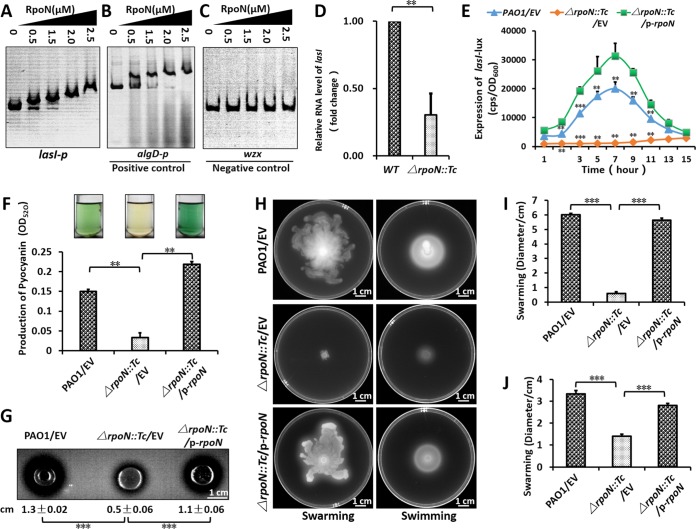FIG 3.
RpoN positively regulated the las-QS system by lasI. (A to C) EMSA showed that RpoN directly bound to the rsaL-lasI intergenic region (A) and the promoter of algD (B) but did not bind to the promoter of wzx (C). PCR products containing the lasI, algD, and wzx promoter regions were added to the reaction mixtures at 30 ng for each well. RpoN protein was added to reaction buffer in lanes with 0, 0.5, 1.25, 2.0, and 2.5 μM. (D) The relative expression of lasI was downregulated in the rpoN mutant. The relative gene expression level in the wild-type PAO1 was set to 1, and the other values were adjusted accordingly. (E) Expression of lasI-lux in PAO1 and its derivatives. Bacteria were grown in LB at 37°C for 12 h with shaking (220 rpm), and then the lasI-lux activity was measured. CPS (counts per second) values represent relative promoter-lux activities. All experiments were independently repeated at least three times, and the data shown represent comparable results. Values represent means ± standard errors of the means (SEM). (F) P. aeruginosa PAO1 and its derivatives were grown in LB medium at 37°C for 16 h with shaking (220 rpm); the presence of the blue-green pigment indicates pyocyanin production. (G) Proteolytic activity of three P. aeruginosa strains on milk plates. (H) Effect of RpoN mutation on motility. Overnight cultures were spotted onto swarming plates (2-μl aliquots), and the plates were incubated at 37°C. The images were captured after 20 h of growth. The experiments were repeated at least three times, and similar results were observed. (I and J) The quantitative analysis (diameter of motility locus) of swarming (I) and swimming (J). P < 0.01 (**) and P < 0.001 (***) compared to the wild-type or complemented strain by Student's t test. Results represent means ± standard deviations (SD), and data are representative of at least three independent experiments. EV represents empty vector pAK1900; p-RpoN represents pAK1900-rpoN.

